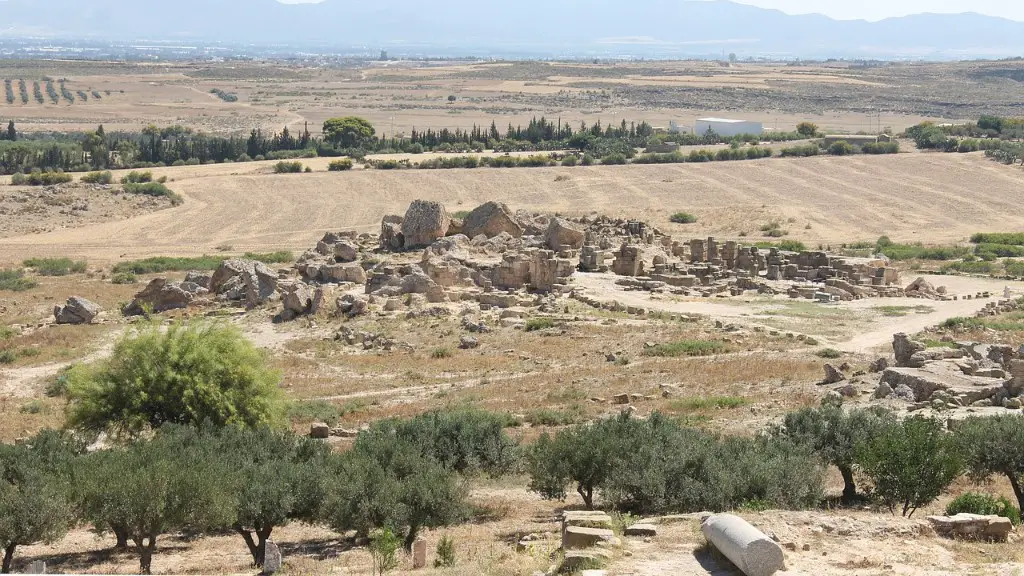Sleeping Arrangements in Ancient Rome
From the late Republic of Rome, around the 2nd Century AD, all the way to the fall of the Roman Empire in 476 AD, the people of Rome spent their nights sleeping in beds made of various materials. To truly understand what kind of bed was used in Ancient Rome, it is important to consider how the Romans lived and the types of materials that were readily available.
The ancient Romans lived in a combination of single-family, multi-family and shared housing. While wealthy Romans often lived in luxurious villas, the average Roman citizen lived in small, cramped dwellings. As such, furniture, including beds, had to be kept as compact and portable as possible. Ancient Roman beds were typically made of wood, but some were made of iron or bronze. They tended to be low-lying, with small mattresses stuffed with feathers or other natural materials, and covered in quilts.
These beds served the dual purpose of sleeping and seating, as they were often used as chairs or couches during the day. Ancient Romans would often prop their beds up with cushions to make them more comfortable for seating during the day. The beds had no headboards, and were adorned with pillows and curtains for added comfort.
More luxurious forms of ancient Roman beds were often reserved for the higher classes. Such beds were made of intricately carved wood or stone, and were often further embellished with gold, silver, and other precious metals and materials. These beds could be quite large, featuring four or more posts to hold up an even larger canopy. They were also often constructed with movable parts, allowing them to easily be taken apart and reassembled.
The ancient Romans used beds for more than just sleeping – they were also often used as a place to entertain and receive guests. Wealthy Romans used their beds as a luxurious couch to meet with visitors, while the average citizen would receive visitors in their beds. The Romans also linked their beds to fertility, as they believed that certain plants and images of mythical gods had the power to grant children to a couple. As such, many Roman beds were adorned with symbols of fertility and fertility deities.
The practice of sleeping in beds was common amongst almost all ancient civilizations, though the materials used to construct the beds would vary depending on the region. Ancient beds could be made of a variety of materials, from wood and metal, to stone and even leather or cloth. With the diverse range of available materials, it is likely that beds were constructed to suit any lifestyle and budget. From the simplest straw mattresses to the grandest beds of gold, the ancient world was certainly well equipped with sleeping accommodations fit for any emperor or peasant.
Bedding Materials and Decorations
The materials used to make beds in Ancient Rome were heavily influenced by the region’s available natural resources and the wealth of the household. Mastiffs, a type of narrow wooden bed, were used by the wealthy and upper classes, as they were able to get these beds from craftsman in the region or import them from other countries. These beds were made of wood and were often elaborately carved and decorated with precious metals, such as gold and silver, or other materials, like alabaster.
The average Roman citizen did not have access to such expensive materials and often resorted to making their own beds. These beds were made of lighter, cheaper materials, such as straw and reeds. These materials would be used to construct unique bed frames, or simply stuffed in to make a simple mattress. Bedding would then be layered on top – usually a combination of wool, linen, or other natural fibers – and covered with brightly coloured quilts or blankets. These beds could be further decorated with plants and images of fertility gods.
The Romans also believed in the power of certain plants to improve the quality of their sleep. Plants such as lavender, rosemary and poppy were often used to fill mattresses and create a pleasant and calming sleeping environment. Pillows were also a common part of ancient Roman beds, though they tended to be rather small, due to the lack of materials available.
Daytime Use of Beds
Though the main purpose of beds in Ancient Rome was for sleeping, they were also used as seating and resting areas during the day. By propping up their beds and adding cushions and blankets, the Romans were able to make their beds into luxurious couches or chairs, providing them with a comfortable place to relax and entertain their guests.
Not only were beds used for sitting, but they were also prominent elements of wedding ceremonies. Weddings in Ancient Rome were commonly held in the groom’s home, and the groom and bride would be seated on a bed during the wedding ceremony. This represented the union of the two families and was a tradition that dates back as far as Ancient Greece.
Beds were also used as a place to perform religious ceremonies and rituals. Symbols of fertility and fertility gods were often placed upon the bed or hanging from the bed’s posts, representing the union of the gods and granting fertility to the couple.
Sleep Habits of Ancient Romans
The sleep habits of ancient Romans varied depending on the region and the wealth of the household. Generally, Roman citizens went to bed rather early, around the 9th hour after sunset, and would get up in the early hours of the morning. This meant that they got approximately five to seven hours of sleep each night.
In wealthier households, where servants were employed to help manage the household, families could sleep a bit later, sometimes going to as late as the 11th hour after sunset. However, this was still much earlier than the night-owls of our modern society.
In the average Roman home, several members of the family would sleep in the same bed. It was common for the parents to share a bed with the youngest children, while the older children would share a bed of their own. This was likely due to the lack of space in their cramped dwellings.
It was also not uncommon for Roman citizens to take afternoon naps, as most mornings were filled with hustle and bustle, preparing for the day ahead. This wasn’t just a luxury, as the additional sleep was likely beneficial for the hardworking Roman citizen.
Types of Beds Available in Ancient Rome
Due to the limited materials available, the types of beds available in Ancient Rome were quite basic. There were two main types of beds – the mastiff and the latiboia. The mastiff was a more luxurious type of bed, as it was made of luxurious materials and often intricately carved. These beds tended to be more elaborate and expensive.
Most Romans, however, would have used the latiboia, a simpler bed made of materials like straw, reeds, or wood. These beds were typically much lower to the ground, and were used both for sleeping and seating. They were also much more portable than the mastiff, allowing for easy transportation and storage.
A Look Into Roman Bedrooms
Ancient Roman bedrooms were typically quite small and sparsely decorated. The majority of the walls were often painted in light colors, such as white or off-white, and were largely unadorned. The beds were often located in the center of the room, or near a window or doorway.
Paintings, sculptures, and other decorations were rare, though wealthy Romans would often decorate the walls of their bedrooms with expensive tapestries or valuable artwork. Some even went as far as to have their ceilings covered in magnificent mosaics, featuring intricate designs and vibrant colors.
The floors in Roman bedrooms also varied depending on the wealth of the household. The average Roman citizen would often have earthen floors, while wealthy Romans might have intricate marble or tiled floors. Of course, the type of bed chosen would also depend on the materials available and the budget of the household.
Conclusion
From the simplest of reed beds to the grandest of golden canopy beds, the ancient Roman’s had a wide range of beds to choose from. This was largely due to the variety of materials available to them, from wood and metals to straw and reeds. Beds were also used for much more than just sleeping – they were also places to entertain, perform religious ceremonies, and celebrate weddings. Ancient Roman beds certainly played a large role in the lives of the people who lived in this era.





